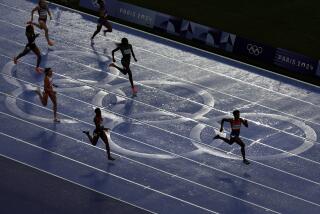Weighing Is the Hardest Part for Judo Champion Lafon : Olympics: She has qualified for Barcelona at 106. But she is worried she won’t be able to shed the necessary pounds.
- Share via
SAN DIEGO — Proud papa thinks his eldest daughter is the most technically gifted judo fighter in the country. This summer, Valerie Lafon’s skills should be on display in the women’s competition at the Summer Olympics in Spain.
But Gerald Lafon believes there’s a good chance Valerie won’t even make it to the mat. And because that would be too painful to watch, he passed on Barcelona.
“If I knew she’d make the weight, I’d be there,” said Gerald, the founder of San Diego Judo in Mira Mesa and Valerie’s coach-for-life. “It’s a glorious opportunity. Not to compete is a reflection on me and on Valerie. But she claims she can do it.”
San Diego’s Lafon was the first athlete in any sport to be selected to the U.S. Olympic team. Judo held its trials back in January, and Lafon, the top-ranked fighter in her weight class four years running, was a shoo-in to make the roster.
“It was anticlimactic really,” Gerald said of the trials. “She’s been so dominant at the national level for so long, it was a little like, ‘What do we do now?’ Making the team was never in doubt. Making her weight, now that’s more of a problem.”
That one isn’t so easily shrugged off. As candid as Valerie was about her weighty issue, she squirmed at divulging how much she has to lose to compete in the 106-pound class Aug. 2, although her dad said she had shed up to 17 pounds for a tournament at least once in the last year.
That’s enough that she’s already talking about the 1996 Summer Games in Atlanta.
“The bad thing about it is I’m constantly thinking about my weight,” said Valerie, a 5-foot-4 athlete. “It’s what I live for. I do think about strategy and stuff, but there’s nothing I can do about that if I don’t make weight.”
Not a day passes when Valerie doesn’t think about how much she has to lose and by when: “I have certain dates and certain weights in mind. I want to keep on track, but if it doesn’t start to come off soon . . . I worry about it.”
Suffice to say, Jenny Craig would be hard-pressed to make this dietary puzzle fit. The biggest challenge is to keep off the weight without losing all the muscle mass.
“Mentally and physically, it’s so draining,” said Valerie, 18. “One of the bigger concerns with us right now is my fat composition (at 106).”
Or lack of. The last time Valerie weighed 106--five months ago--she took a test that determined she had an unfathomable 1% body fat and was bone dry. Look dad, no fluids.
“The guy who did the test couldn’t believe I could get down that low. That’s when it really scared me,” she said.
Unlike a gymnast, Valerie doesn’t need to impress a judge. Her measuring stick is the scale. Like a wrestler, she has to compete at a set weight or she will not only sit out this competition, she might have to refund the air fare to Spain.
To help Valerie take off the weight properly, the Lafons, who said they’re accepting any advice they can get, recently sought out a nutritionist. No more cutting water by limiting fluid intake or wearing plastics to sweat it out--common but risky practices in the sport.
She started on a protein starvation plan two weeks ago and has cut the starch from her diet. Fruits and vegetables are now her staples.
“I can eat a little bread,” she said. “The other day I was fixing pasta for my family and I had a small bowl. It felt great having it. It gave me a lot of energy.”
These days, all of it is devoted to judo classes and a fitness regimen geared toward reducing fat. She runs, she rows, she cycles. She avoids any activity, mainly the weight room, that might add muscle to her frame.
Not all of them are ideal methods, but she’s running out of options.
At the trials, Valerie was a far cry from the strong athlete she said she naturally is. There, she looked emaciated and felt rotten.
“My dad said I looked like I just got out of a concentration camp. My competition suffered,” she said. “I had nothing (physically) left.”
Gerald, shocked by what he saw, said she was white as a ghost and about as effective.
“Horrible judo,” was his description. “She went four minutes with a girl she usually beats in 30 seconds.”
For her age, height and dense bone structure, Valerie is fighting well under what her normal weight should be.
When Valerie was 14, she weighed 103, so her logical weight division was 106. But that was four inches ago, when she was 5 feet tall. What worked four years ago is obsolete now that her body is undergoing dramatic changes.
“Womanhood’s set in. She’s developed a chest. She’s not a little girl anymore,” Gerald said. “It’s a shameful thing because she merits a place at the Olympics. She’s beaten people third and fourth in the world, but she just can’t function at 106. She’s too dehydrated.”
Generally, Valerie’s opponents are four to five inches shorter than she is. Her teammates all fight at heavier weights, yet she towers over them, too. And since most are in their mid- to late-20s, their weights have stabilized somewhat.
“A lot of them don’t understand what I’m going through,” she said.
Why did Valerie feel compelled to fight at a weight she has outgrown?
Valerie was raised to be a winner. When she was an infant, she’d watch her father’s judo practices from a playpen set up in the gym. She took her first judo class at the age of 4. She won her first competition at 7.
The girl she beat was a regional champion. “We’re not talking about just beating her, but thrashing her,” said Gerald, who neither applauds nor accepts mediocrity.
Her first national championship soon followed, at which point Gerald knew Valerie’s talents were special. At 13, she was traveling internationally.
In 1986, the judo school implemented “Target ‘92,” a master plan that culminated in a trip to the Olympics, with Valerie as the targeted traveler.
“From the time she won her first nationals, we knew she’d make it to the Olympics,” Gerald said.
Said Valerie: “When I was 7, I was told I would be on the Olympic team . . . (At the trials) it wasn’t as exciting for me as for the other girls because it was totally obvious that I would be on the team. Besides, none of those girls had ever beaten me.”
Not in that division, anyway.
At 106 she was unbeaten, untouched, unfettered.
“At the U.S. Open in 1988, I was a nobody,” said Valerie. “I beat the No. 1 girl in 20 seconds. She was 24, I was 14. I was like, ‘That’s the No. 1 player? I had a lot more confidence when I was younger. Now I doubt myself. But that’s basically because of the weight.”
At 114, the weight at which her dad and her national coach wanted her to fight, she was ranked second and had a 1-1 record against the top-ranked fighter last year.
But after training so long and so hard, Valerie was unwilling to take a chance of fighting at the higher weight and not making the team.
At the trials, the top-ranked athletes could lose their first fight and theoretically still make the team. But for lower-ranked fighters, one loss meant the end of the road.
“I didn’t want to take the chance,” she said in one breath, admitting in the next that she was taking almost as big a gamble by staying in the lighter division.
Of course, Valerie didn’t put those troublesome pounds on overnight. She said she gained a few pounds a year but never dreamed it would come to this. But Gerald said his daughter had trouble making weight for 18 months and hid the problem until three months before the trials.
“All that time she was cutting all that weight. If I had known, we would have moved her up, but by the time we found out, it was too late to train for 114,” Gerald said. “She told me ‘I’ve been at 123, where have you been?’ I asked her how was it that I should have known?”
Gerald would hear reports that she was weighing in at tournaments at 123, but he said Valerie maintained she was closer to 114, which was a reasonable weight to cut.
“The difference between 114 and over 120 is astronomical,” Gerald said. “She hid her weight problem, like we were going to come down on her and get mad. There’s a difference between a growing woman who gains weight and a full-grown woman who wants to pig out and not pay attention to her weight.”
Now they must deal the best they can with the situation at hand. With varying degrees of acceptance, father and daughter talk about the possibility that she might not fight this summer.
“She’ll learn from it,” Gerald said. “There’s more to judo than fighting. She claims she has two more (Olympics) in her, so this is kind of a throw-away Olympics for her. There’s 1996 and there’s even 2000. I can only hope she’ll think about weight in the future. She’ll fight at 134 or 145 if need be. We’ve talked about going up that high. She can be a living example of what not to do to be in a division.”
If she had it to do over again, Valerie said she would go for 114, but she’s taking responsibility for what now seems a poor judgment call.
“It was my choice,” she said.
While Gerald appears hard on his daughter, he is not without compassion for her. Valerie said she feels his support 100%.
“You can’t tell an 18-year-old to get rid of a sure shot for a maybe. I couldn’t do it. She decided to go 106 and I felt all right about it,” he said.
So now, she takes things one day at a time. On the advice of her nutritionist, she weighs herself weekly instead of daily and tries not to get consumed by the fact that the weight isn’t coming off as quickly as she’d like it to.
After all, there is Atlanta.
“I’ll be at my peak in 1996. I even think 2000 is a possibility,” she said.
That’s one trip dad should have no problem making.
More to Read
Go beyond the scoreboard
Get the latest on L.A.'s teams in the daily Sports Report newsletter.
You may occasionally receive promotional content from the Los Angeles Times.






